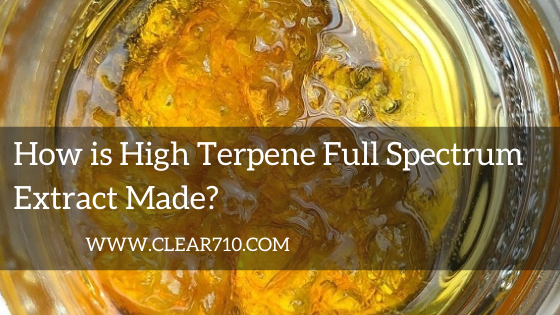Uncategorized
How is High Terpene Full Spectrum Extract Made?
Extraction techniques have come a long way from the butane hash oil days of the past.
Today, premium products tend to lean towards full-spectrum, low-temperature extractions. These full-spectrum extractions fall into two categories: High cannabinoid full spectrum extract (HCFSE) and high terpene full spectrum extract (HTFSE). With a robust cannabinoid and terpene profile, these products have exponentially better flavor and possibly more medicinal value than isolates. Here we focus on HTFSE sauce, including the basics of how to make HTFSE.
WHAT IS HIGH TERPENE FULL SPECTRUM EXTRACT (HTFSE)?
Full-spectrum extracts are concentrated cannabinoids. The process pulls out the many valuable therapeutic molecules from the plant, to leave the non-therapeutic molecules like fats, lipids, and waxes behind.
Traditionally, the industry used extraction techniques that pulled either single or select cannabinoids (THC, CBD, etc.) from the cannabis trichome. Partially, the method was to blame, but so were the demands within the industry. In the early days, consumers wanted pure, high potency isolates. Considering both THC and CBD are relatively robust cannabinoids, they stood up under high-heat extractions. High temperatures destroy most other compounds.
There are two types of full-spectrum extracts: High cannabinoid full spectrum extract (HCFSE) and high terpene full spectrum extract (HTFSE). As their names suggest, the former focuses on preserving a wide range of cannabinoids and the latter on a full terpene profile. A full spectrum extraction process naturally produces both HCFSE and HTFSE.
The cannabinoid extract takes on a sugary or diamond-like consistency, often referred to has HTFSE diamonds or HTFSE sugars. The terpene extraction maintains an oily or sauce-like texture, with crystals of THCA suspended in the sauce. HTFSE is also called ‘The Sauce’ of “Terp Sauce” by industry vets.
Under most conditions, HCFSE will have a higher potency of THCA than HTFSE, although a high-quality HTFSE can contain up to 50 percent THCA. With a focus on terpene preservation, this concentrate always keeps a higher percentage of terpenes (13 to 40 percent), than the cannabinoid extraction.
HOW IS HTFSE MADE?
The primary extraction requires four components: pressure, sub-zero temperatures, a hydrocarbon solvent with a low-temperature boiling point, and a high-quality flower.
Unlike many other conventional concentrates, the HTFSE extraction process requires highly specialized extraction equipment. Do-it-you-self home growers need not apply, as highly advanced laboratory equipment is essential to the operation.
All HTFSEs require high-quality input material. Other extractions, designed for isolated cannabinoid output do not always need quality plant material. Because HTFSE works to preserve the natural profile of the plant, producers must source flower with a healthy terpene and cannabinoid profile. The terpene and cannabinoid profile of the original material is critical to the quality of the final product.
Most producers use premium fresh frozen cannabis flowers as the starting material. Although a live resin approach is not absolutely required, there is an argument that fresh frozen flower a better terpene profile compared to cured, dried flower.
Extractors maintain low temperatures throughout the primary extraction to preserve the sensitive, volatile compounds of the fresh frozen plant material.
During this primary process, the extraction is also dewaxed to remove the non-valuable compounds from the concentrate, (waxes, lipids, and fats). Using sub-zero temperatures, producers can quickly and easily separate these undesirable materials from the extraction.
A secondary step gradually introduces low heat into the process, to separate the solvent from the concentrate. Again, the solvent choice is critical here, as the boiling point needs to be low enough that it still protects the valuable therapeutic compounds in the sauce.
Image Courtesy of Apothecary Extracts, Colorado Springs, CO
MINING HTSFE DIAMONDS
The concentrate industry isn’t on the same page when it comes to definitions. There is a high degree of variation between what one producer considers a full spectrum extraction and another.
Some producers work to pull all cannabinoids and terpenes out of the plant in a single extraction, while others reintroduce terpenes (synthetic or natural) post-extraction. Although controversial, some companies reintroduce THCA diamonds back into the terpene extraction. Many people would not consider this a true HTFSE, however.
Premium extractors aim to develop HTFSE diamonds within the full spectrum concentrate. Diamonds are the crystalline THCA molecules, pulled from the fresh frozen flower. The higher the quality of the original plant material, the higher the THCA content, and the easier the diamond formation becomes.
Live resin lends itself to crystal formation more so than cured resin, primarily because of a higher THCA level. Certain harvests may not produce any diamonds at all, depending on environmental stressors, cannabinoid profiles, and other factors. Although HTFSE diamonds are the goal, they are not always achievable.
THE INDUSTRY MOVES TOWARDS A FULL SPECTRUM PREFERENCE
As the concentrate industry evolves, it becomes increasingly more intelligent. Improved technologies and extraction techniques preserve a wide spectrum of valuable cannabinoids beyond the THC and CBD molecules, which have formerly dominated the market.
Both HCFSE and HTFSE ensure the full-spectrum of compounds from the original material make it into the final, concentrated end product – without the need for reintroduction post-extraction. First and foremost, these extractions have a better aroma and flavor profile, and it may also have improved therapeutic value.

